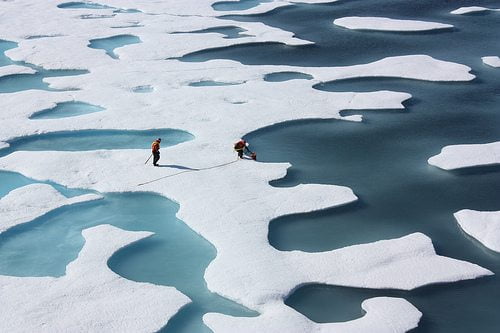

Environment
Arctic sea ice slightly down on 2013
The latest data from Europe’s CryoSat has revealed that Arctic sea ice in October was slightly lower than that recorded in 2013. However, researchers added that the data does not necessarily indicate a turn in the long-term downward trend.
In 2012 Arctic sea ice cover shrank to its lowest ever point. According to a study average ice volume between 2003 and 2008 was 11,900 cubic km in the autumn months, but between 2010 and 2012 this dropped by over a third to 7,600 cubic km.
Arctic sea ice now stands at 10,100 cubic km, compared to 10,900 cubic km last year. The European Space Agency (ESA) added that the volume is the second highest since measurements began in 2010, and the five-year average is “relatively stable”. However, they added the findings do not suggest that the long-term downward trend is changing.
“We must take care when computing long-term trends as this CryoSat assessment is short when compared to other climate records,” explained Professor Andrew Shepherd, from the University College London and the University of Leeds.
“For reliable predictions, we should try other approaches, like considering what is forcing the changes, incorporating the CryoSat data into predictive models based on solid physics, or simply waiting until more measurements have been collected.”
CryoSat was designed to measure sea-ice thickness across the entire Arctic Ocean, enabling scientist to monitor changes in volume. The amount of ice fluctuates depending on the seasons but longer-term satellite records show a constant downward trend in ice extent during all season. One of CryoSat’s key missions is to establish if ice volume is following a similar pattern.
Rachel Tilling, who is working on the CyroSat measurements as part of her PhD studies, commented, “October is interesting because it is the first month we get data directly following the sea-ice minimum in September, so that’s where we see the largest inter-annual variability in our volume estimates.”
A separate study recently published analysed satellite imagery over a 30 year period and found that the Arctic’s ice-free season is becoming longer by an average of five days every 10 years.
Photo: NASA Goddard Space Flight Center via Flickr
Further reading:
Scientists to investigate Arctic sea ice melt with sensors and aquatic robots
Arctic sea ice continues its worrying decline
Antarctic sea ice reaches record high levels as Arctic levels hit record low


 Environment10 months ago
Environment10 months agoAre Polymer Banknotes: an Eco-Friendly Trend or a Groundswell?

 Environment12 months ago
Environment12 months agoEco-Friendly Home Improvements: Top 7 Upgrades for 2025

 Features9 months ago
Features9 months agoEco-Friendly Cryptocurrencies: Sustainable Investment Choices

 Features11 months ago
Features11 months agoEco-Friendly Crypto Traders Must Find the Right Exchange





























